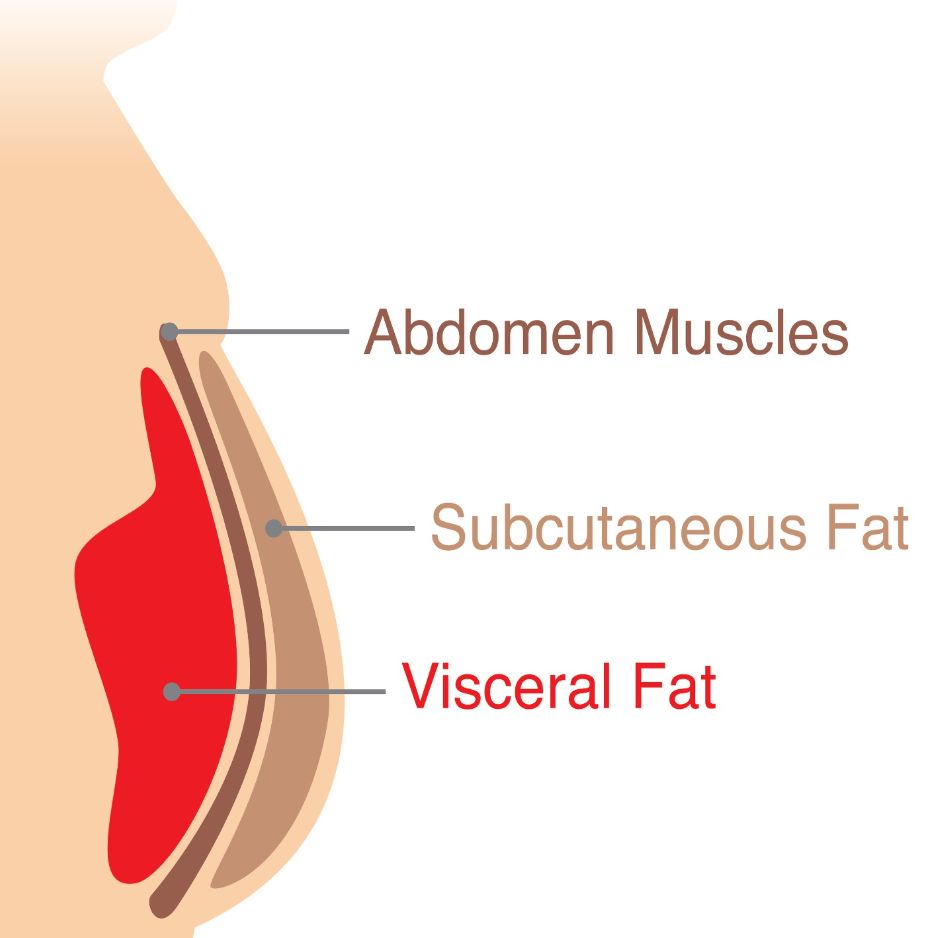Subcutaneous Fat: What It Is and How to Reduce It

Are you concerned about your subcutaneous fat? You're not alone. Subcutaneous fat, the layer of fat that lies directly beneath the skin, can be a challenging aspect of your health to understand and manage. In this article, we'll explore what subcutaneous fat is, why it can be harmful, and how you can reduce it.
Get weekly updates.
What is Subcutaneous Fat?
Before we delve into the details, let's first define what subcutaneous fat is. It is the layer of fat that lies just beneath your skin, and it's the most common type of fat in the body. Most people have it, and it's generally harmless unless you have too much of it.
The Difference Between Subcutaneous and Visceral Fat
Subcutaneous fat is often confused with visceral fat, the fat that surrounds your organs. Although both are undesirable, they differ in their location and health effects. Subcutaneous fat sits directly beneath your skin and is often visible, while visceral fat sits deep inside your body and can be harder to detect.
Visceral fat is considered more dangerous than subcutaneous fat because it's associated with an increased risk of heart disease, type 2 diabetes, and other chronic diseases. Visceral fat can also release hormones and other chemicals that can contribute to inflammation and insulin resistance.
The Role of Subcutaneous Fat in the Body
Subcutaneous fat has various important functions, such as regulating body temperature, cushioning the organs, and providing a source of energy. However, excessive levels of subcutaneous fat can lead to several health problems and increase the risk of developing chronic diseases.
For example, carrying excess subcutaneous fat around your midsection is associated with an increased risk of heart disease, type 2 diabetes, and certain cancers. Additionally, excess subcutaneous fat can put pressure on your joints and lead to joint pain and mobility issues.
Factors Affecting Subcutaneous Fat Distribution
Several factors influence subcutaneous fat distribution in the body. Genetics play a significant role, as do hormonal imbalances, poor diet and lack of exercise, stress, and sleep deprivation.
For instance, women tend to carry more subcutaneous fat than men, particularly in their hips, thighs, and buttocks. Hormonal changes during menopause can also cause women to gain more subcutaneous fat around their midsection.
Poor diet and lack of exercise can also contribute to excess subcutaneous fat. Consuming a diet high in processed foods, sugar, and saturated fat can lead to weight gain and an increase in subcutaneous fat. On the other hand, a diet rich in fruits, vegetables, whole grains, and lean protein can help reduce subcutaneous fat levels.
Stress and sleep deprivation can also affect subcutaneous fat levels. When you're stressed, your body releases cortisol, a hormone that can increase subcutaneous fat levels. Lack of sleep can also disrupt your hormones and lead to weight gain and an increase in subcutaneous fat.
Understanding your risk factors is crucial in managing subcutaneous fat levels. By making lifestyle changes such as eating a healthy diet, exercising regularly, managing stress, and getting enough sleep, you can reduce your risk of developing health problems associated with excess subcutaneous fat.
Causes of Excess Subcutaneous Fat
Excessive subcutaneous fat can result from several factors, including genetics, hormonal imbalances, poor diet, lack of exercise, stress, and sleep deprivation.
Genetics and Family History
Some people are more predisposed to excess subcutaneous fat due to their genetics. If you have a family history of obesity and being overweight, you are likely to develop subcutaneous fat as well. However, genetics is not the only factor that contributes to subcutaneous fat accumulation.
Research has shown that lifestyle factors, such as diet and exercise, can modify the genetic risk of subcutaneous fat accumulation. Therefore, even if you have a family history of obesity, you can still manage your subcutaneous fat levels through a healthy lifestyle.
Hormonal Imbalances
Hormonal imbalances can also contribute to excess subcutaneous fat. Hormones like insulin, cortisol, and estrogen can affect how your body gains and loses fat. For instance, insulin resistance, a condition where your cells become resistant to insulin, can lead to subcutaneous fat accumulation.
Moreover, hormonal imbalances can occur due to poor lifestyle habits and aging. For instance, as you age, your body's production of growth hormone decreases, which can lead to subcutaneous fat accumulation.
Poor Diet and Lack of Exercise
A diet high in sugar and unhealthy fats can lead to excess subcutaneous fat. Additionally, lack of exercise or a sedentary lifestyle can cause fat to accumulate in various parts of your body, leading to a range of health problems.
Research has shown that a combination of a healthy diet and regular exercise can help reduce subcutaneous fat levels. A healthy diet should include foods that are rich in fiber, protein, and healthy fats, while avoiding processed and high-sugar foods.
Stress and Sleep Deprivation
High levels of stress and poor quality of sleep can increase cortisol levels, which can lead to subcutaneous fat accumulation. Chronic exposure to stress and lack of sleep over long periods can result in a significant increase in subcutaneous fat levels.
Therefore, managing stress levels and getting adequate sleep are essential for maintaining healthy subcutaneous fat levels. Techniques such as meditation, yoga, and deep breathing can help reduce stress levels, while getting at least 7-8 hours of sleep per night is recommended.
Conclusion
In conclusion, excess subcutaneous fat can result from several factors, including genetics, hormonal imbalances, poor diet, lack of exercise, stress, and sleep deprivation. However, by adopting a healthy lifestyle that includes a balanced diet, regular exercise, stress management, and adequate sleep, you can manage your subcutaneous fat levels and maintain optimal health.
Health Risks Associated with Excess Subcutaneous Fat
Excess subcutaneous fat, commonly known as stubborn fat, can be harmful and increase the risk of various health problems. Subcutaneous fat is the fat that is stored just under the skin, and it can be found in various parts of the body, including the hips, thighs, and belly. Below are some possible health risks associated with excess subcutaneous fat.
Increased Risk of Cardiovascular Disease
Excess subcutaneous fat increases the risk of cardiovascular diseases, such as heart attacks and strokes. Studies have shown that people with higher levels of subcutaneous fat are more prone to these health issues. The reason for this is that subcutaneous fat produces hormones and other substances that can lead to inflammation and damage to the arteries. This can result in the accumulation of plaque in the arteries, which can eventually lead to heart attacks and strokes.
Insulin Resistance and Type 2 Diabetes
Excess subcutaneous fat can reduce insulin sensitivity, leading to insulin resistance, and may increase the risk of type 2 diabetes. Insulin resistance can also lead to other metabolic disorders, such as high blood pressure, abnormal cholesterol levels, and cardiovascular disease. The accumulation of subcutaneous fat in the abdominal area is particularly harmful as it is associated with a higher risk of insulin resistance and type 2 diabetes.
Inflammation and Chronic Disease
Excess subcutaneous fat can trigger inflammation in the body, which can lead to chronic disease. Studies have shown that inflammation resulting from excess subcutaneous fat can contribute to arthritis, asthma, cancer, and Alzheimer's disease. This is because subcutaneous fat produces inflammatory cytokines, which can lead to chronic inflammation in the body. Chronic inflammation can damage tissues and organs, leading to various health problems.
In conclusion, excess subcutaneous fat can be harmful and increase the risk of various health problems. It is important to maintain a healthy weight and body fat percentage to reduce the risk of these health issues. A healthy diet and regular exercise can help to reduce subcutaneous fat and improve overall health and well-being.
How to Measure Subcutaneous Fat
Subcutaneous fat is the layer of fat that sits just beneath the skin. It is different from visceral fat, which surrounds the organs and is more dangerous to your health. Measuring your subcutaneous fat levels can help you understand your body composition and make informed decisions about your health.
To determine your subcutaneous fat levels accurately, you can use various methods:
Body Mass Index (BMI)
BMI measures the ratio of your weight to your height and can estimate your body fat levels. While BMI can be a useful tool, it doesn't directly measure subcutaneous fat levels. BMI is calculated by dividing your weight in kilograms by your height in meters squared. A BMI of 18.5-24.9 is considered healthy, while a BMI of 25 or higher is considered overweight or obese.
Skin Calipers
Skin calipers measure your body's subcutaneous fat levels by pinching your skin and measuring the thickness of the skinfold. This method is inexpensive and easy to carry out, but it may not be highly accurate. To use skin calipers, you will need to pinch the skin in different areas of your body, such as your triceps, abdomen, and thighs. The measurements are then added up and compared to a chart to determine your body fat percentage.
Dual-Energy X-ray Absorptiometry (DEXA)
DEXA uses a low-level X-ray to measure your body fat levels and can provide a highly accurate reading of your subcutaneous fat levels. This method is more costly and is typically used in clinical settings. During a DEXA scan, you will lie on a table while a scanner passes over your body. The scan takes about 10-15 minutes to complete and can provide information about your bone density as well as your body fat levels.
In addition to these methods, there are other ways to estimate your subcutaneous fat levels, such as bioelectrical impedance analysis (BIA) and hydrostatic weighing. BIA involves passing a small electrical current through your body to estimate your body fat levels, while hydrostatic weighing involves submerging your body in water to measure your body's density. These methods may not be as accurate as DEXA, but they can still provide useful information about your body composition.
Regardless of the method you choose, it's important to remember that subcutaneous fat levels are just one aspect of your overall health. Maintaining a healthy diet, getting regular exercise, and managing stress are all important factors in achieving optimal health.
Reducing Subcutaneous Fat: Tips and Tricks
If you're looking to reduce your subcutaneous fat levels, there are several steps you can take:
Follow a Healthy Diet
A healthy diet comprising whole foods, fruits, vegetables, protein, and healthy fats can help reduce subcutaneous fat levels. Avoid processed foods and foods high in sugar and unhealthy fats.
Incorporate Exercise into Your Daily Routine
Exercise is essential in reducing subcutaneous fat levels. Aim to complete at least 30 minutes of moderate-intensity exercise, such as walking, jogging, or cycling, every day.
Reduce Stress and Improve Sleep Quality
Reducing stress and improving your sleep quality can help lower cortisol levels and reduce subcutaneous fat levels. Try practicing relaxation techniques such as yoga or meditation or aim for at least 7-8 hours of quality sleep every night.
Conclusion
Subcutaneous fat can be a complex issue, but understanding its causes, measures, and potential health risks is essential in managing and reducing subcutaneous fat levels. Incorporating a healthy diet, exercise, and stress management practices into your daily life can lead to a healthier, leaner body.


